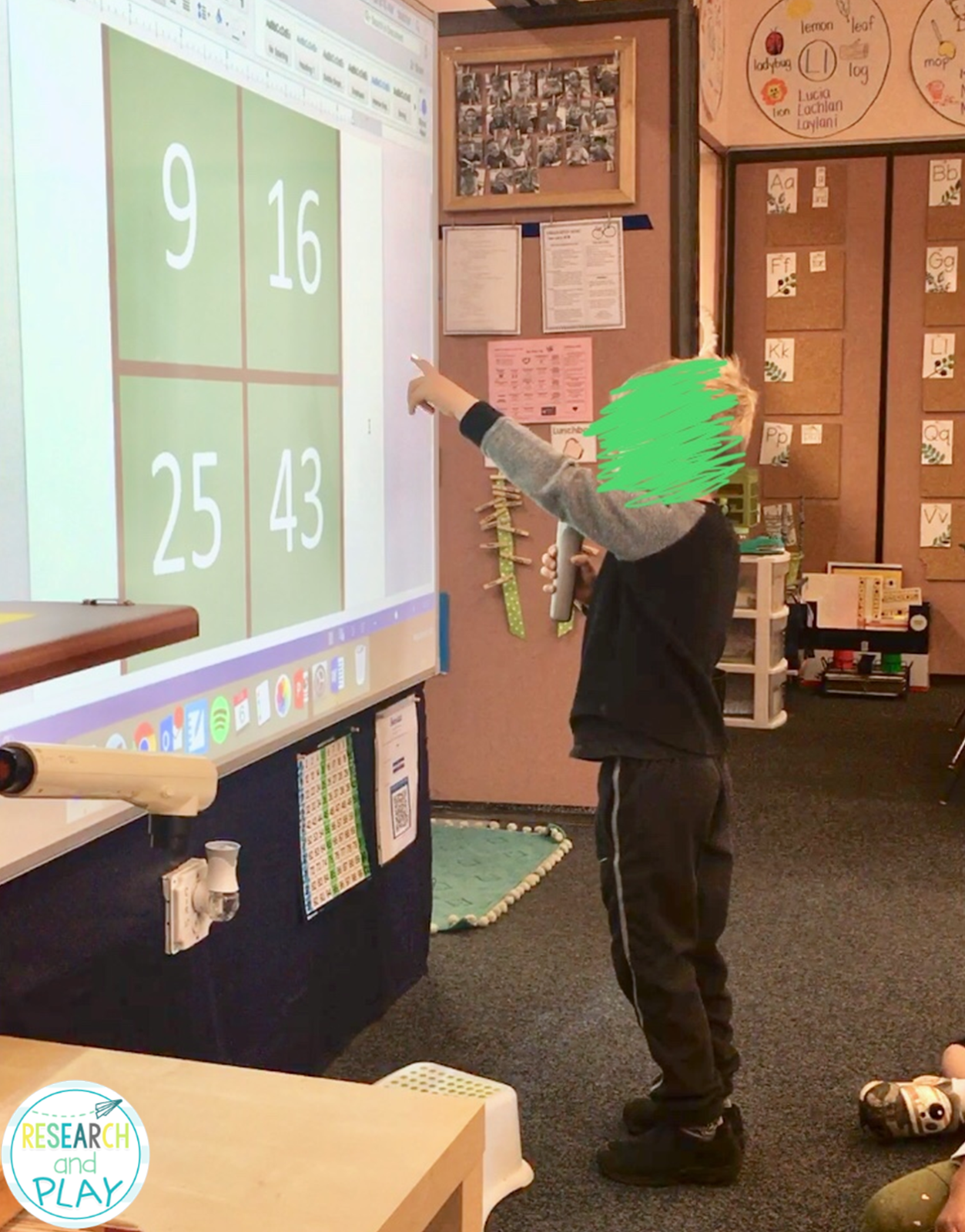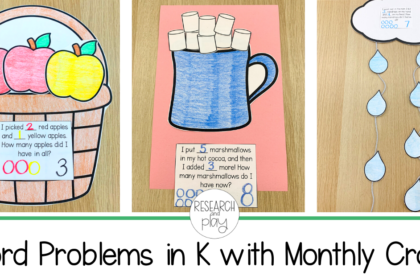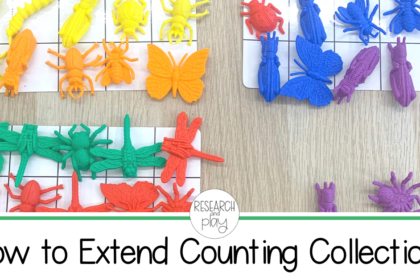If you told me you wanted to come in and watch me teach, I’d probably invite you in during our number talk. Not because I feel like I’m a rockstar math teacher, but because you’ll be floored at the level of math thinking you’ll hear my students doing. Since creating a daily math routine this year, I’ve seen my students do and understand things that I didn’t think kindergartners could do. So, I want to share what I’ve learned!
In this post, I’ll explain the difference between a number talk and a warm up, when I do these routines, and how students share out. Then I’ll break down each individual number talk and warm up that we do in my classroom. I’ll also share any resources I use that make these routines possible. Spoiler alert: There aren’t many things you need to do these routines. That’s why I like them so much!
What’s the difference between a “number talk” and a “warm up”?
Ok so right off the bat, let’s define what number talks and warm ups are and can look like. For some, they are one in the same. For others, they mean different things. But for both, students are both thinking AND talking about the math. The thing that underlies them both is the amount of mathematical argumentation you’ll hear your students do, and it’s amazing.
Number talks in my classroom occur when my class is all looking at the same number, addition or subtraction problem, number bond, number comparison, counting sequence, number chart, or equation. We talk about what we notice, and then I pose a question. After some think time, my students have a structured response in the form of a sentence stem that they share with a partner. Then I choose 3-5 students to come up front and share out what they talked about.
Warm ups in my classroom also occur when my whole class is looking at the same thing, but what we are looking at generally doesn’t involve numbers. Rather, we are looking at pictures, talking about shapes, positions, sizes, measuring objects, or comparing by attribute. The structure is the same in that we take time looking/talking about what we see, think about it, share with a partner, and then a few come up and share with the group.
When do these math routines happen?
I like to begin my math block with a routine. Right after we finish calendar time, we take about 15 minutes for our number talk or warm up. Afterwards, we go to math rotations, and you can read more about those HERE.
One crucial component of these math routines is that you limit it to 15 minutes max. You want this to feel like a mini lesson, a warm up, a quick way to check in with skills. You’ll be doing the majority of your teaching of your math goal during your small group rotation.
Another thing, make sure you do these every day! These math routines should be a non-negotiable for your instructional time with students. Even on those crazy schedule days, make sure you don’t skip your math warm up or number talk! Trust me, it will pay off.
How do students share out?
Getting kindergartners comfortable with sharing their math thinking doesn’t happen overnight. It takes lots of explicit modeling! I have to be very focused on how I model the way in which I want students to respond. One way that I encourage students to share is by making sure I repeat everything they say in the way they say it. It makes them feel heard and that their ideas are important. It also helps to clarify any misunderstandings and allows students to further explain themselves if they want.
Another strategy is to use sentence stems. I always have them displayed for my students to refer to and use. I make sure that I am explicit in my modeling of these sentence stems by using the same language that the stems use. When I ask students to respond, I remind them to use a stem. Sometimes I let them choose whichever stem they want, but other times I use a clip or pin next to the specific stem I want them to use. I also make sure that students use sentence stems when sharing with their partner. Since this is a crucial part to the success of these math routines, I’ve put all of the stems I use into one resource that you can find here.
There are so many ways teachers can structure a number talk. I’ll break down my favorite activities and the ones I find most meaningful and impactful.
Counting Sequences and Number Charts
Whether it is early September or late March, make sure you are continuing to talk about counting. Don’t assume your students have mastered the skill of counting or a counting sequence. Challenge them and push them with a counting number talk.
Display a number line. Draw it yourself or have it pre-made. Leave some numbers off, and challenge your students to find the missing numbers. DON’T let them give you the number without also giving you their reasoning for choosing that number! This is the heart of a number talk, explaining their thinking.
Do the same with a number chart. Color/cover some numbers, and have your students figure out the missing numbers and prove how they know. Talk about patterns on the chart (how each row has the same beginning number or each column has the same ending number). Talk about skip counting and how students can use that to find numbers.
These number talks don’t need to be fancy or complex! Basic, fast, and meaningful, that’s all you want.
 |
| These students looked at a flash card of 5 and shared the strategies they used to count the pictures. |
Addition or Subtraction Problems
These number talks are always fun because students solve them so many ways! Write an addition/subtraction problem on the board, but don’t solve it. Students can solve and compare their answers with their partner. Easy.
One way to make this number talk more challenging is to leave out a variable. For example, 2+__=5. This kind of number talk pushes students to solving with proof. This is also challenging because they won’t have paper, pencils, or manipulatives to use!
You can vary your vocabulary depending on where your students are in developing this skill. Early on, you may want to start with “2 and 1 is __” then eventually move on to “2 + 1 is ___.” In that same vain, for subtraction, you could start with “4 take away 2 is ___.” then move on to “4 – 2 is ___.” You can eventually write the problems with the equal sign when your students are ready.
 |
| I used two flash cards, one with a digit and one with a picture, to push my students’ ability to join even when the numbers are in different formats. |
Number Bonds (Composing/Decomposing)
Want to really hear your students’ math thinking? Ask them to show you how to break a number apart! I like starting these types of number talks by writing the number on the board, then drawing that many circles. Ask students how many ways you can color the circles to break apart the number (8 is 4 and 4, 5 and 3, etc.). Eventually we move on to using number bonds just so students can become familiar with the tool, but the premise remains.
Remember, students won’t have any manipulatives in front of them, so this number talk takes a lot of thinking! The proof component can come when you select a few students to come up and share with the group. Allow them to draw on the board or use manipulatives to prove their thinking.
Comparing Numbers
This one can be tailored to fit your students’ needs in lots of ways. I typically use flash cards that have pictures on one side and the number on the other side. I found a set from the Target dollar spot about 5 years ago that I still love! I will start with pictures, then move to numbers later on. I put two cards next to each other, then I’ll point to a card and they call out “More!” or “Less!” We do it as a fast, group call-out warm up for a while, but then I’ll eventually show them two cards and have them share with their partner instead of calling out.
When letting students share with the group, allow them to draw or touch the pictures so they can prove their thinking.
Equal Equations (True/False)
These number talks are fun because you typically get lots of disagreement! We play true/false often because of how much my students argue. Math argumentation is good! I draw an equal sign in the middle of the board. If I want to focus on addition, I’ll write addition equations on each side of the equal sign. I’ll do about 3 or 4 sets during the 15 minutes. For the first set, I typically keep them equal (2+2 = 3+1). The students will think about if this is true or false, then give me a thumbs up when they’re ready to share. They share with their partner first, using a sentence stem, and then I choose someone to come share in front of the class.
Then I erase and either do another true set or a false set. If I did a false set (2+3 = 3+3), the students would share with their partners, and then the student who was chosen to come up front to share would have to PROVE why the equations are not equal.
An extension would be asking students to find ways to make false equations true. For example, a student could explain that 2+3=3+3 is not true because if you add the numbers, 5 is on one side and 6 is on the other. A way to make it equal would be to add one more to the 5 to make it 6. It’s amazing to listen to all the ways that students can make equations true.
You may notice more “arguing” because of the ways that students solve problems or understand addition or subtraction. The power is in the share outs! Make sure you choose many different students to come up and share, especially students whose ideas may be wrong or arguable.
 |
| This was when we first started doing this kind of number talk. She was pointing to the digits and proving it was equal because the digits were the same on each side! |
We do warm ups when I want to focus on skills other than number sense or operations. Even if shapes or measurement aren’t your focus areas of the moment, don’t forget that skills need to spiral and loop in kindergarten!
Which One Doesn’t Belong? (WODB)
If you want to use numbers for this warm up, you can, but I love doing this with pictures of food, road signs, weird shapes, cards, all kinds of other stuff! The premise of WODB is having students look at 4 objects and decide which one doesn’t belong. That’s it. The best part of this activity is that there really is no wrong answer! The other best part is that WODB allows students to explain their thinking in many different ways, and those students who are typically quiet or unsure can have a space to speak up!
Want some excellent FREE resources for WODB? Go to this website: wodb.ca – it’s where I get all of the pictures that I use.
 |
| Don’t be afraid to choose WODB pictures that seem hard! My students did an awesome job explaining their thinking with this one! |
Describe, Draw, Describe (DDD)
This is the only warm up we do that involves students needing something in their hand. A DDD involves students looking at a picture, typically displayed via projector or document camera. The idea behind DDD is that students will describe the picture by being prompted by you first (“What do you see?”). You can have a few students come up one at a time to point out the things they see. You keep your part to a minimum, only prompting students to tell about what they see. Many students will naturally talk about the individual parts of the picture, shapes they see, amounts of things, or other details. After a couple of minutes, students will use a pencil and paper and draw the picture. You will only prompt by saying, “Draw what you see.”
I typically set a timer for 5 minutes. In that time, rotate around and notice how students are drawing. How’s their perspective? Are they able to make a visual match to the picture? Can they position the things in the picture in the same way? If students get finished drawing, prompt them to label the picture or write a sentence about what they see.
To find pictures, I just search for blackline masters or coloring pages via Google. I only choose pictures that have some sort of visual depth like motion (like how the rocket below is diagonal because it is moving), differences in perspective (foreground/background objects of different sizes), many kinds of shapes, or objects that are have a position component (things are beside, on top of, behind…).
 |
| This one was fun because it accompanied our viewing of the SpaceX rocket launch! |
SHARE OUTS = THE WHOLE POINT
Make sure that you don’t skip this part. Giving students think time and partner talk time is important, but the share outs at the end are so meaningful. They allow for students to prove their thinking to more than one person, they allow the other students to see different perspectives and ways of solving, and they allow you to hear how your students are thinking about numbers. One of my math mentors once said, “If you’re not doing the share out, you shouldn’t even do the warm up at all.” That’s why sentence stems are HUGE in developing academic language and math argumentation. If you let students share out without sentence stems, they aren’t as likely to develop the right kind of vocabulary.
Be Intentional with Partnering (Especially Early in the Year)
If you have a rug with designated spots for students to sit, this makes this part easier. Put certain students next to each other for your warm up time. I typically try to partner students who are working at different levels, but not too different that one partner won’t be able to understand their partner’s thinking. You can also think about language development and have students paired in a way that one partner’s use of language and sentence stems can support the other partner. Now that it’s February and we have a flexible seating classroom, my students just partner with someone sitting near them, but I’m comfortable with this since these math warm ups have been part of our math routine since August.
Turn Off Your Voice!
One of the hardest things for me to do when I first started doing these math routines every day was to just stop talking. Being a kindergarten teacher, I’m so accustomed to wanting to scaffold and steer and support my students’ thinking. But one of the most important parts of facilitating these math routines is to be as quiet as you can, only asking clarifying questions or re-stating what your students share. I set up the routine, ask my focus question, then I stay fairly quiet. I walk around and listen to partner talk, and then when students are up front sharing, I just ask for clarification or to re-state. At the end, I’ll come back and wrap up the routine as a whole, “Today we did a DDD so that we can notice the shapes and positions of objects.” And that’s about it! Assessment tip: Have the notes app on your phone (or an actual notepad) for taking notes of what students share. This is AWESOME when I need to check it with standards and have real-time anecdotal records of my students’ thinking.
Create a Safe Environment for Sharing
It makes me cringe to hear stories from other teachers where they’ve done activities similar to these math routines where students get up front to share, and then another student blurts out something negative or derogatory from the audience. There’s no faster way to completely shut down a student’s thinking and make them feel like they’re bad at something. And no matter how much damage control you do as the teacher, the words have already been said. So make sure your classroom is a space where students know that each individual has something special to share, that all ideas are welcome, and that even if we disagree or think someone is wrong, we can let them know in ways that help them rather than hurt.
I can’t wait for you to use these math routines. They have given all of my students a voice and a chance to feel like a mathematician. We have to start young to turn off those negative feelings about math, and these math routines allow for ALL students to share and talk about math in an open, supportive environment. My students literally cheer for these math routines when we start them. So try them for yourself!







Do you alternate number talks and math warm ups? How often do you each?